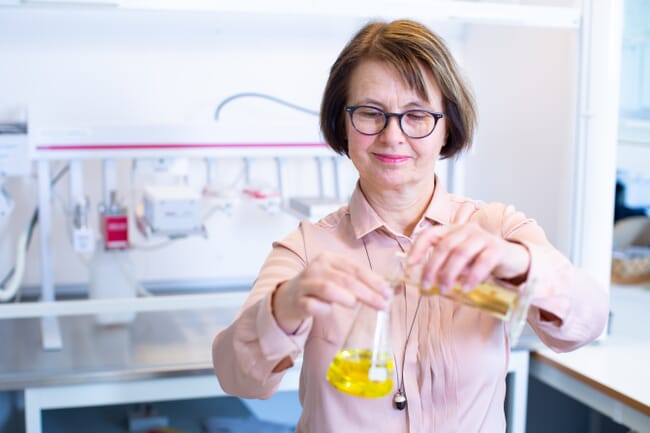The demand for fish oil rich in omega-3 has long been greater than the supply. Sources that can meet the requirement for omega-3 in the diet of farmed fish have until now been scarce. However, new sources of omega-3 are partly on the market and research shows that these are safe to use in farmed salmon feed.
Nofima scientists have tested two new sources. One of them is canola oil extracted from a rapeseed plant which is genetically modified to produce the omega-3 fatty acids DHA and ALA. The other is the microalgae Schizochytrium sp, which is not genetically modified but naturally rich in DHA. These sources are partially available on a commercial scale.
The results show that both of them provide good performance, quality, composition of fatty acids and health for the salmon.

Why research sources of omega-3?
Both humans and fish require the long, marine omega-3 fatty acids EPA and DHA to maintain good health. What we receive from fish oil derived from wild fish is not enough to meet the needs of a growing population and aquaculture industry. Therefore, several sources of marine omega-3 are needed. Some omega-3 is used in health food products, some in animal feed and a large proportion in feed for farmed fish. Omega-3 levels in Norwegian farmed salmon have previously fallen and one now assumes that the lower limit has been reached. This trend can now be stopped by utilising new sources.
In the research project “New omega-3 sources in salmon feed”, the aim was to obtain scientific evidence regarding new feed sources and their effect on fish performance, quality and health. The project manager was Nofima’s senior scientist Bente Ruyter.
Nofima carried out feeding trials using canola oil in salmon diets both in freshwater and seawater land-based fish tanks in Norway. Canola oil was added to the feed in increasing amounts. A parallel feeding trial has also been carried out on juvenile salmon in warmer water in Australia. This was to test canola oil at two different growth rates. This was important in order to detect any effects that might occur when fish grow rapidly during early stages of life. Nofima also carried out feeding trials where salmon were fed with microalgae from when they were 100 grams to when they reached their slaughter size.
The salmon that were fed the new ingredients were analysed for growth, composition, muscle quality and health. One of the purposes of the microalgae trial was to look at sensory parameters such as odour and taste.
The feed sources were good for the salmon
“We know that salmon need the fatty acids EPA and DHA in order to maintain good health. This research shows that salmon can utilise these fatty acids both from the new sources of omega-3 and from fish oil in the same way, says Ruyter.
The main findings are:
- Canola oil has a favourable fatty acid profile compared to conventional plant oils, with high levels of the omega-3 fatty acids alpha-Linolenic acid and DHA. Analysis of a number of health markers suggests that this is a safe source of oil in salmon feed.
- Canola oil in salmon feed in both freshwater and seawater provides equivalent growth rates as fish oil, and better skin and muscle colour.
- Environmental pollutants could not be detected in salmon fed with canola oil.
- Biomass from the algae Schizochytrium sp is a good source of DHA in the diet of salmon and also contributes to better muscle colour. This ingredient created no differences regarding the odour and flavour of the fillet compared to salmon fed with fish oil.
Global challenge for the industry
Access to greater volume of feed ingredients rich in omega-3 is considered as one of the major challenges regarding growth in the aquaculture industry, both in Norway and internationally.
“It now looks like there are solutions, but it will also be important in the future to utilise sources of omega-3 in fish as optimally as possible”, says Ruyter.
The assessment of whether oil from genetically modified rapeseed can be permitted for use in feed in Norway depends on government regulations. Only then will the industry be able to decide whether to use canola oil. Knowledge gained from this project will contribute to this assessment.
About the project
- Funded by the Norwegian Seafood Research Fund (FHF). The project was established after a joint announcement with the Research Council of Norway.
- Project period 2015-2019
- Budget: NOK 15.6 million
- Ingredients tested: Aquaterra canola oil from Nuseed Pty Ltd (Australia)
- Schizochytrium sp (heterotrophic microalgae) from Alltech Inc (USA)
- The project is led by Nofima and is in collaboration with CSIRO (Australia) and the Institute of Marine Research.
- The final technical report can be found here
- Facts about the project can be found here


